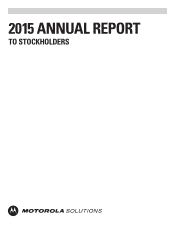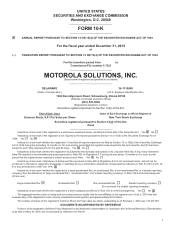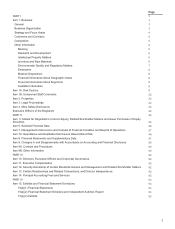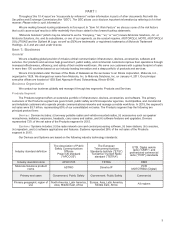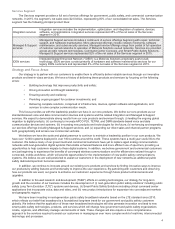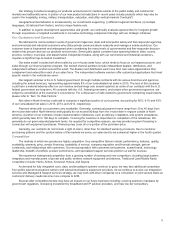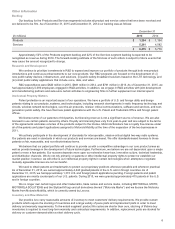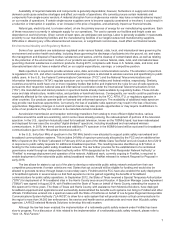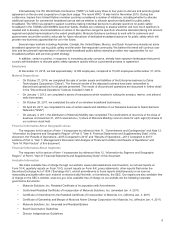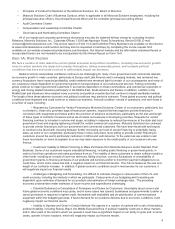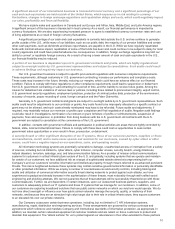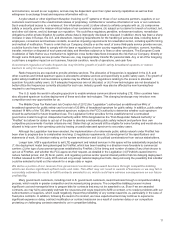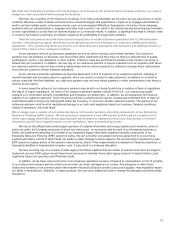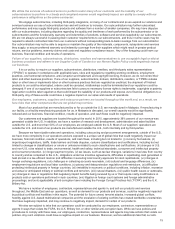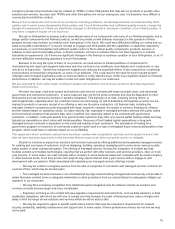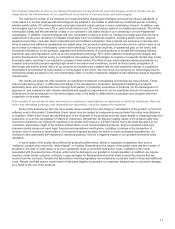Motorola 2015 Annual Report Download - page 8
Download and view the complete annual report
Please find page 8 of the 2015 Motorola annual report below. You can navigate through the pages in the report by either clicking on the pages listed below, or by using the keyword search tool below to find specific information within the annual report.7
Availability of required materials and components is generally dependable; however, fluctuations in supply and market
demand could cause selective shortages and affect our results of operations. We currently procure certain materials and
components from single-source vendors. A material disruption from a single-source vendor may have a material adverse impact
on our results of operations. If certain single-source suppliers were to become capacity constrained or insolvent, it could result in
a reduction or interruption in supplies, or an increase in the price of supplies, and adversely impact our financial results.
Natural gas, electricity and, to a lesser extent, oil are the primary sources of energy for our manufacturing operations. Each
of these resources is currently in adequate supply for our operations. The cost to operate our facilities and freight costs are
dependent on world oil prices. Given current oil spot rates, we anticipate cost savings. Labor is generally available in reasonable
proximity to our manufacturing facilities and the manufacturing facilities of our largest outsourced manufacturing suppliers.
Difficulties in obtaining any of the aforementioned resources, or a significant cost increase, could affect our financial results.
Environmental Quality and Regulatory Matters
Some of our operations use substances regulated under various federal, state, local, and international laws governing the
environment and worker health and safety, including those governing the discharge of pollutants into the ground, air, and water,
the management and disposal of hazardous substances and wastes, and the cleanup of contaminated sites, as well as relating
to the protection of the environment. Certain of our products are subject to various federal, state, local, and international laws
governing chemical substances in electronic products. During 2015, compliance with these U.S. federal, state, and local, and
international laws did not have a material effect on our capital expenditures, earnings, or competitive position.
Radio spectrum is required to provide wireless voice, data, and video communications service. The allocation of spectrum
is regulated in the U.S. and other countries and limited spectrum space is allocated to wireless services and specifically to public
safety users. In the U.S., the Federal Communications Commission (“FCC”) and the National Telecommunications and
Information Administration (“NTIA”) regulate spectrum use by non-federal entities and federal entities, respectively. Similarly,
countries around the world have one or more regulatory bodies that define and implement the rules for use of radio spectrum,
pursuant to their respective national laws and international coordination under the International Telecommunications Union
(“ITU”). We manufacture and market products in spectrum bands already made available by regulatory bodies. These include
voice and data infrastructure, mobile radios, and portable or hand-held devices. Consequently, our results could be positively or
negatively affected by the rules and regulations adopted from time to time by the FCC, NTIA, ITU, or regulatory agencies in
other countries. Our products operate both on licensed and unlicensed spectrum. The availability of additional radio spectrum
may provide new business opportunities. Conversely, the loss of available radio spectrum may result in the loss of business
opportunities. Regulatory changes in current spectrum bands may also provide opportunities or may require modifications to
some of our products so they can continue to be manufactured and marketed.
As television transmission and reception technology transitions from analog to more efficient digital modes, various
countries around the world are examining, and in some cases already pursuing, the redevelopment of portions of the television
spectrum. In the U.S., spectrum historically used for broadcast television, known as the 700MHz band, has been redeveloped
and deployed for new uses (the so-called “digital dividend” spectrum), including broadband and narrowband wireless
communications. In 2016, this trend continues and additional TV spectrum in the 600MHz band will be auctioned for broadband
communications (part of the “Broadcast Incentive Auction”).
In the U.S., thirty-four MHz of spectrum in the 700 MHz band is now allocated to support public safety narrowband and
broadband communications systems. This includes 24 MHz of spectrum previously allocated by the FCC and an additional ten
MHz of spectrum (the “D block”) allocated in February 2012 as part of the Middle Class Tax Relief and Job Creation Act of 2012
in response to public safety requests for additional broadband spectrum. The resulting law also identified up to $7 billion in
funding for the nationwide public safety broadband network. The law further provides for the establishment of a centralized
governance model through an independent authority within NTIA designated as the “First-Responder Network Authority” or
“FirstNet” to manage deployment and operation of the network. Additional work, currently ongoing in FirstNet, is required to
enable deployment of the nationwide public safety broadband network. FirstNet released its network Request for Proposal in
early 2016.
The law allows for states to opt out of the plan to develop a nationwide public safety network and perform their own
competitive procurements if certain criteria are met. States that opt out would still be eligible for funding and would also be
allowed to generate revenue through leases to secondary users. FirstNet and the FCC have also enabled the early deployment
of broadband systems in several areas so that field experience can be gained regarding the benefits of broadband
communications for public safety operations. In September 2012, the State of Texas received a Special Temporary Authorization
("STA") for deployment of 14 broadband sites in the Harris County area around Houston. A Spectrum Manager Lease Agreement
("SMLA") was signed in August 2014, with FirstNet and the State of Texas on behalf of Harris County, extending the access to
this spectrum for three years. The State of Texas and Harris County, with assistance from Motorola Solutions, have deployed
broadband equipment and applications and successfully demonstrated the benefits such systems can bring to FirstNet and other
officials. FirstNet also entered into a spectrum lease with the State of California on behalf of Los Angeles Regional Interoperable
Communications System Authority ("LA-RICS") to allow for a radio system that will provide mission critical communications for
the region’s more than 34,000 law enforcement, fire service and health service professionals and more than 80 public safety
agencies. LA-RICS selected Motorola Solutions to develop this radio system.
Although the law has been enacted, the implementation of a nationwide public safety network under FirstNet has been
slow to progress. For a discussion of risks related to the implementation of a nationwide public safety network, please refer to
"Item 1A, Risk Factors."

